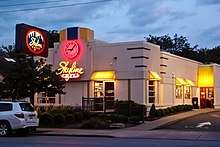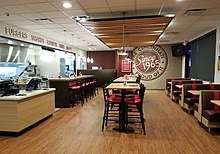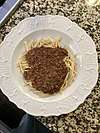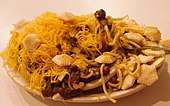Cincinnati chili
Cincinnati chili (or Cincinnati-style chili) is a Mediterranean-spiced meat sauce used as a topping for spaghetti (a "two-way") or hot dogs ("coneys"), both dishes developed by Macedonian immigrant restaurateurs in the 1920s. In 2013, Smithsonian named it one of "20 Most Iconic Foods in America".
 4-way Cincinnati chili | |
| Alternative names | Cincinnati-style chili |
|---|---|
| Type | Meat sauce |
| Place of origin | United States |
| Region or state | Greater Cincinnati |
| Created by | Tom Kiradjieff |
| Main ingredients | ground beef, tomato paste, spices |
| Similar dishes | Rochester hot sauce, Hot wiener sauce |
Ingredients include ground beef, water or stock, tomato paste, spices such as cinnamon, nutmeg, allspice, clove, cumin, chili powder, bay leaf, and in some home recipes unsweetened dark chocolate in a soupy consistency. Other toppings include cheese, onions, and beans; specific combinations of toppings are known as "ways". Ways are often served with oyster crackers and a mild hot sauce. Cincinnati chili is almost never served or eaten by the bowl.
Its name evokes comparison to chili con carne, but the two are dissimilar in consistency, flavors and serving methods, which for Cincinnati chili more resemble Greek pasta sauces and the spiced-meat hot dog topping sauces seen in other parts of the United States.
While served in many local restaurants, it is most often associated with the over 250 independent and chain "chili parlors" (restaurants specializing in Cincinnati chili) found throughout greater Cincinnati with franchise locations throughout Ohio and in Kentucky, Indiana, and Florida. A small chain also has locations in the Middle East. The dish is the Cincinnati area's best-known regional food.
Origins and history
Cincinnati chili originated with immigrant restaurateurs from Greece who were trying to expand their customer base by moving beyond narrowly ethnic styles of cuisine.[1][2]:28 Slavic Macedonians Tom and John Kiradjieff immigrated from Argos Orestiko, fleeing the Balkan Wars, ethnic rivalries, and bigotry, in 1921.[3] They began serving a "stew with traditional Mediterranean spices"[2]:27 as a topping for hot dogs[2]:27[4] which they called "coneys" in 1922 at their hot dog stand located next to a burlesque theater called the Empress, which they named their business after. Tom Kiradjieff used the sauce to modify a traditional Greek dish, speculated to have been pastitsio,[5][6] moussaka[2]:28 or saltsa kima[7][8] to come up with a dish he called chili spaghetti.[2]:27 He first developed a recipe calling for the spaghetti to be cooked in the chili but changed his method in response to customer requests and began serving the sauce as a topping, eventually adding grated cheese as a topping for both the chili spaghetti and the coneys, also in response to customer requests.[2]:28
To make ordering more efficient, the brothers created the "way" system of ordering.[2]:29 The style has since been copied and modified by many other restaurant proprietors, often fellow Greek and Macedonian immigrants who had worked at Empress restaurants before leaving to open their own chili parlors,[2]:40[9]:244 often following the business model to the point of locating their restaurants adjacent to theaters.[2]:25


Empress was the largest chili parlor chain in Cincinnati until 1949, when a former Empress employee and Greek immigrant, Nicholas Lambrinides, started Skyline Chili.[10] In 1965, four brothers named Daoud, immigrants from Jordan, bought a restaurant called Hamburger Heaven from a former Empress employee.[2]:40 They noticed that the Cincinnati chili was outselling the hamburgers on their menu and changed the restaurant's name to Gold Star Chili.[10] As of 2015, Skyline (over 130 locations)[11] and Gold Star (89 locations)[12] were the largest Cincinnati chili parlor chains, while Empress had only two remaining locations, down from over a dozen during the chain's most successful period.[2]:84
Besides Empress, Skyline, and Gold Star, there are also smaller chains such as Dixie Chili and Deli and numerous independents including the acclaimed[2]:84 Camp Washington Chili. Other independents include Pleasant Ridge Chili, Blue Ash Chili, Park Chili Parlor, Price Hill Chili,[13] Chili Time, Orlando based Cincinnati Chili Company, and the Blue Jay Restaurant,[14] in all totalling more than 250 chili parlors.[2]:9 In 1985 one of the founders of Gold Star Chili, Fahid Daoud, returned to Jordan, where he opened his own parlor, called Chili House.[15] Outside of Jordan, Chili House as of 2020 had locations in Iran, Iraq, Libya, Oman, Palestine, Turkey and Qatar.[16]
In addition to the chili parlors, some version of Cincinnati chili is commonly served at many local restaurants. Arnold's Bar and Grill, the oldest bar in the city, serves a vegetarian "Cincy Lentils" dish ordered in "ways."[17] Melt Eclectic Cafe offers a vegan 3-way. For Restaurant Week 2018, a local mixologist developed a cocktail called "Manhattan Skyline," a Cincinnati chili-flavored whiskey cocktail.[19]
The history of Cincinnati chili shares many factors in common with the apparently independent but simultaneous development of the Coney Island hot dog in other areas of the United States. "Virtually all"[9]:233 were developed by Greek or Macedonian immigrants who passed through Ellis Island as they fled the fallout from the Balkan Wars in the first two decades of the twentieth century.
Preparation, ordering, serving and eating
Raw ground beef[4] is crumbled in water and/or stock, tomato paste and seasonings are added, and the mixture is brought to a boil and then simmered for several hours to form a thin meat sauce. Many recipes call for an overnight chill in the refrigerator to allow for easy skimming of fat and to allow flavors to develop,[7] then reheating to serve.[20] Typical proportions are 2 pounds of ground beef to 4 cups of water and 6 oz tomato paste to make 8 servings.[20]
 Ground beef is crumbled into water.
Ground beef is crumbled into water. Spices and tomato paste are added and the water brought to a boil, then simmered several hours.
Spices and tomato paste are added and the water brought to a boil, then simmered several hours. Finished Cincinnati chili
Finished Cincinnati chili Spaghetti topped with chili is a "two-way".
Spaghetti topped with chili is a "two-way". A "four-way onion" gets onions on top of the chili.
A "four-way onion" gets onions on top of the chili. Cheese on top makes it a "four-way".
Cheese on top makes it a "four-way".
The "way" system

Ordering Cincinnati chili is based on a specific ingredient series: chili, spaghetti, shredded cheddar cheese, diced onions, and kidney beans.[10] The number before the "way" of the chili determines which ingredients are included in each chili order.[4] Customers order a:
- Two-way: spaghetti topped with chili[4] (also called "chili spaghetti")
- Three-way: spaghetti, chili, and cheese[4]
- Four-way onion: spaghetti, chili, onions, and cheese[4]
- Four-way bean: spaghetti, chili, beans, and cheese[4]
- Five-way: spaghetti, chili, beans, onions, and cheese[4]

Some chili parlors will also serve the dish "inverted": cheese on the bottom, so that it melts.[4][21] Some restaurants, among them Skyline and Gold Star, do not use the term "four-way bean", instead using the term "four-way" to denote a three-way plus the customer's choice of onions or beans. Some restaurants may add extra ingredients to the way system; for example, Dixie Chili offers a "six-way", which adds chopped garlic to a five-way.[24] Cincinnati chili is also used as a hot dog topping to make a "coney", a regional variation on the Coney Island chili dog, which is topped with shredded cheddar cheese to make a "cheese coney". The standard coney also includes mustard and chopped onion.[25] The "three-way" and the cheese coney are the most popular orders.[2]:10[26]
Very few customers order a bowl of plain chili.[27][28] Most chili parlors do not offer plain chili as a regular menu item. Polly Campbell, food editor of The Cincinnati Enquirer, calls ordering a bowl of chili, "Ridiculous. Would you order a bowl of spaghetti sauce? Because that's what you're doing."[29]
Serving and eating
Ways and coneys are traditionally served in a shallow oval bowl.[2]:15[9]:243 Oyster crackers are usually served with Cincinnati chili,[9] and a mild hot sauce such as Tabasco is frequently available to be used as an optional topping to be added at the table.[25] Locals eat Cincinnati chili as if it were a casserole, cutting each bite with the side of the fork instead of twirling the noodles.[30][31]
Misnomer
The name "Cincinnati chili" is often confusing to those unfamiliar with it because the term "chili" evokes the expectation of chili con carne,[25][32][33] which it "bears no resemblance to."[34] Cincinnati chili is a Mediterranean-spiced[33][35] meat sauce[36] for spaghetti or hot dogs, and is very seldom eaten by the bowl[26][37] as is typical with chili con carne. It is common for Cincinnatians to describe it starting with, "Well, it's not really chili..."[27] Cincinnati Enquirer food editor Chuck Martin and Cincinnati Magazine dining editor Donna Covrett agree, "It is not chili."[38][39] Cincinnati chili is always seasoned with cinnamon, allspice, cloves, cumin, nutmeg, and chili powder.[10][20] Many home recipes call for a small amount of dark unsweetened chocolate,[20] but according to Dann Woellert, author of The Authentic History of Cincinnati Chili, "There is no chili parlor in Cincinnati that uses chocolate in its chili."[2]:141 It is normally of a thin consistency,[35] closer to a soup than a stew,[14] and contains no vegetables or chunks of meat, though it is common to find large pieces of cayenne pepper hulls in Empress chili. The flavors, consistency and serving method are more similar to Greek pasta sauces[35] or the spiced meat sauces used to top hot dogs in Rochester and other parts of Upstate New York, Rhode Island, and Michigan than they are to chili con carne.[2]:10
Reception
Cincinnati chili is the area's "best known regional food".[40] According to the Greater Cincinnati Convention and Visitors Bureau, Cincinnatians consume more than 2,000,000 lb (910,000 kg) of Cincinnati chili each year, topped by 850,000 lb (390,000 kg) of shredded cheddar cheese.[2]:10 Overall industry revenues were $250 million in 2014.[41]
Anthony Bourdain called it "the story of America on your plate".[42] National food critics Jane and Michael Stern wrote, "As connoisseurs of blue-plate food, we consider Cincinnati chili one of America's quintessential meals"[43] and "one of this nation's most distinctive regional plates of food".[4][9]:247 Huffington Post named it one of "15 Beloved Regional Dishes".[44] In 2000, Camp Washington Chili won a James Beard Foundation America's Classics Award.[45][46] In 2013, Smithsonian named Cincinnati chili one of "20 Most Iconic Foods in America",[47] calling out Camp Washington Chili as their destination of choice. John McIntyre, writing in The Baltimore Sun, called it "the most perfect of fast foods", and, referring to the misnomer, opined that "if the Greeks who invented it nearly a century ago had called it something other than chili, the [chili] essentialists would be able to enjoy it."[32] In 2015, Thrillist named it "the one food you must eat in Ohio".[48]
Eater called it "America's most controversial plate of pasta".[49] It is common for those unfamiliar with it, confused by the misnomer and expecting chili con carne, to "scorn it"[32][50] as a poor example of chili.[32][35][51][52] A 2013 piece published by the sports and culture website Deadspin went so far as to call it "horrifying diarrhea sludge".[53]
In popular culture
Blues musician Lonnie Mack, who was born and raised just outside Cincinnati, released a guitar instrumental called Camp Washington Chili on his 1986 album Second Sight.[54][55] Country music duo Big & Rich sang about flying through Cincinnati and grabbing a bowl of Skyline chili in their song "Comin' to Your City" on the 2005 album of the same name.[56]
Cincinnati chili is used allegorically as a symbol for vapid social interaction and social disconnection in the 2015 animated film Anomalisa, as the main character when on a business trip to Cincinnati is exhorted in multiple banal encounters to try the local specialty.[57][58][59][60]
Similar dishes
- Chili dog, the generic term for a hot dog topped with meat sauce[61]
- Chili John's, founded in Green Bay, Wisconsin by a Lithuanian immigrant, offers "Green Bay chili", a dish similar to a five-way created in 1913[9]:245
- Chili mac, which tops pasta with chili con carne rather than Cincinnati chili
- Coney Island hot dog, a dish similar to a coney developed by Greek-Macedonian immigrants, apparently independently, across the Midwest[61]
See also
- Cuisine of the Midwestern United States
- List of regional dishes of the United States
- Filipino spaghetti, another example of a fusion-cuisine spaghetti dish
- Barbecue spaghetti, another fusion-cuisine spaghetti dish
References
- Smith, Andrew (2013). The Oxford Encyclopedia of Food and Drink in America, Volume 2. Oxford University Press. p. 417. ISBN 978-0-1997-3496-2. OCLC 835958679.
- Woellert, Dann (2013). The Authentic History of Cincinnati Chili. The History Press. ISBN 978-1-60949-992-1. Retrieved November 20, 2015.
- Necessary, Kevin. "Chili is a Cincinnati staple, and we have these guys to thank for it". WCPO. Archived from the original on February 4, 2019. Retrieved February 3, 2019.
- Campbell, Polly (February 26, 2015). "Area has taste all its own". The Cincinnati Enquirer. Archived from the original on July 14, 2018. Retrieved June 4, 2015.
- Manley, Mackenzie; Noel, Jude. "The Cincinnati Chili Trail". City Beat. Archived from the original on June 15, 2018. Retrieved June 14, 2018.
- Dixler, Hillary (January 27, 2015). "How Camp Washington's Chili-topped Spaghetti Became Legend". Eater. Archived from the original on May 22, 2015. Retrieved May 22, 2015.
- Becker, John. "All About Cincinnati Chili". The Joy of Cooking. Archived from the original on May 31, 2015. Retrieved May 30, 2015.
- "What Is It?". Eater. Archived from the original on June 14, 2018. Retrieved June 13, 2018.
- Stern, Jane & Stern, Michael (2009). 500 Things to Eat Before It's Too Late: And the Very Best Places to Eat Them. Houghton Mifflin Harcourt. p. 243. ISBN 978-0-547-05907-5. Archived from the original on May 10, 2016. Retrieved November 20, 2015.
- Herrmann Loomis, Susan (April 16, 1989). "Fare of the County; A City's Romance With a Bowl of Chili". The New York Times. Archived from the original on April 10, 2014. Retrieved September 16, 2011.
- "Skyline chili: franchise information". Archived from the original on August 29, 2015. Retrieved July 18, 2015.
- Campbell, Polly (February 26, 2015). "Gold Star Chili turns 50, welcomes family as CEO". The Cincinnati Enquirer. Retrieved July 18, 2015.
- Kindelsperger, Nick (August 14, 2018). "Is Cincinnati chili actually chili? A dive into the city's most famous dish". Chicago Tribune. Archived from the original on November 8, 2018. Retrieved November 7, 2018.
- Larkin, Jess (May 5, 2015). "Top 5 Local Chili Parlors". Cincinnati Magazine. Archived from the original on May 22, 2015. Retrieved May 21, 2015.
- Devina Divecha (January 7, 2016). "Caterer Middle East: Restaurateur interview: Chili House". Retrieved May 21, 2020.
- "Chili House: Find Us". Retrieved May 21, 2020.
- "Arnold's Bar & Grill". September 12, 2011. Archived from the original on May 26, 2015. Retrieved May 22, 2015.
- "Metropole to serve Cincinnati chili-inspired whiskey cocktail". WCPO. Archived from the original on June 15, 2018. Retrieved June 14, 2018.
- Rombauer, Irma S.; Becker, Marion Rombauer & Becker, Ethan (1997). The Joy of Cooking. New York: Scribner. p. 672. ISBN 0-684-81870-1.
- Herrman Loomis, Susan (April 16, 1989). "FARE OF THE COUNTRY; A City's Romance With a Bowl of Chili". The New York Times. Archived from the original on July 20, 2017. Retrieved November 8, 2018.
- "Our Menu". Dixie Chili and Deli. Archived from the original on September 24, 2015. Retrieved October 1, 2015.
- "Cincinnati Chili: Pass the Tabasco". Fodor's. Archived from the original on May 29, 2015. Retrieved May 22, 2015.
- Conan, Neal (August 22, 2005). "Talk of the Nation/Cincinnati Chili". NPR. Archived from the original on April 2, 2015. Retrieved May 22, 2015.
- Bonem, Max (February 24, 2015). "5 Reasons Cincinnati Chili is Misunderstood". Paste. Archived from the original on May 22, 2015. Retrieved May 22, 2015.
- Hoffman, Ken (August 23, 2009). "That Cincinnati chili — what is it?". Houston Chronicle. Archived from the original on July 11, 2015. Retrieved July 10, 2015.
- "That's So Cincinnati". The Cincinnati Enquirer. Archived from the original on December 14, 2018. Retrieved December 14, 2018.
- "Ode to Authentic Cincinnati Style Chili". CincinnatiUSA.com. Archived from the original on June 15, 2018. Retrieved June 14, 2018.
- Chapman, Ben (April 13, 2009). "The Long Weekend: Cincinnati's Chili Tradition". The Washington Post. Archived from the original on January 19, 2019. Retrieved November 8, 2018.
- McIntyre, John (July 15, 2015). "Chili and Essentialism". The Baltimore Sun. Archived from the original on July 21, 2015. Retrieved July 17, 2015.
- Boyer, Mike (September 10, 2004). "Cincinnati chili stakes its claim". The Cincinnati Enquirer. Archived from the original on July 28, 2012. Retrieved May 22, 2015.
- Stern, Jane & Stern, Michael (1999). Chili Nation. Broadway Books. pp. 111. ISBN 0767902637.
- Cross, Danny (July 8, 2015). "So You've Probably Heard of Cincinnati Chili But what is it and where should you eat it?". Cincinnati CityBeat. Archived from the original on July 10, 2015. Retrieved July 9, 2015.
- Neman, Daniel (January 21, 2015). "Finding comfort in chili". St. Louis Post-Dispatch. Archived from the original on June 14, 2017. Retrieved June 9, 2015.
- Niesen, Julie (October 17, 2018). "Cincinnati Chili: A History". WVXU. Archived from the original on November 8, 2018. Retrieved November 8, 2018.
- Covrett, Donna. "And Tom Said Let There Be Chili. And God Said, Don't Forget the Onions". Cincinnati Magazine. Retrieved November 8, 2018.
- Calvert, Scott (August 13, 2002). "Hometown of the other chili". The Baltimore Sun. Archived from the original on July 10, 2015. Retrieved June 4, 2015.
- Coleman, Brent (August 27, 2015). "How Skyline Chili became a Cincinnati icon". WCPO-TV. Archived from the original on August 29, 2015. Retrieved August 29, 2015.
- Zarnitz, Eric (February 26, 2015). "WLWT examines Cincinnati style chili's history on National Chili Day". WLWT. Archived from the original on July 10, 2015. Retrieved June 4, 2015.
- Harper, Brianna. "Anthony Bourdain, enemy of food snobbery, was a fan of Cincinnati chili". WCPO. Archived from the original on June 13, 2018. Retrieved June 13, 2018.
- Stern, Michael & Stern, Jane (July 1999). "Cincinnati Chili: An Homage To Our Hometown Obsession". Cincinnati Magazine. p. 43. ISSN 0746-8210. Archived from the original on May 29, 2016. Retrieved November 20, 2015.
- "15 Beloved Regional Dishes". The Huffington Post. October 20, 2011. Archived from the original on September 24, 2015. Retrieved July 12, 2015.
- Huguelet, Cate (August 30, 2015). "America's famous food capitals". USA Today. Archived from the original on September 5, 2015. Retrieved September 5, 2015.
- "James Beard Foundation America's Classics Award Winners". James Beard Foundation. Archived from the original on June 1, 2008. Retrieved May 22, 2015.
- Koren, Marina (August 6, 2013). "The 20 Most Iconic Food Destinations Across America". Smithsonian. Archived from the original on June 19, 2015. Retrieved June 9, 2015.
- Gentile, Dan (September 6, 2015). "THE ONE MUST-EAT FOOD IN EVERY STATE". Thrillist. Archived from the original on November 20, 2015. Retrieved October 29, 2015.
- "America's Most Controversial Plate of Pasta". Eater. Archived from the original on June 14, 2018. Retrieved June 13, 2018.
- Stewart, D.L. (October 28, 2015). "Don't like Cincinnati chili? You 'must'". Dayton Daily News. Archived from the original on November 1, 2015. Retrieved October 29, 2015.
- Robinson, Amelia (October 18, 2013). "Skyline Chili ranked worst in nation, called 'abominable garbage-gravy'". Dayton Daily News. Archived from the original on October 21, 2013.
- Morago, Greg (October 2, 2015). "The polarizing and incendiary politics of chili". Houston Chronicle. Archived from the original on October 3, 2015. Retrieved October 17, 2015.
- Burneko, Albert (October 17, 2013). "The Great American Menu: Foods Of The States, Ranked And Mapped". Deadspin. Archived from the original on April 28, 2016. Retrieved May 5, 2016.
- Hay, Lee. "Lonnie Mack special re-broadcast". www.wvxu.org. Retrieved August 2, 2019.
- "Camp Washington Chili". Amazon.com. Retrieved March 19, 2016.
- "Comin' to Your City". Archived from the original on April 8, 2016. Retrieved March 19, 2016.
- Hornaday, Ann (January 7, 2016). "'Anomalisa' contemplates desire, love and loneliness, by way of puppets". The Washington Post. Archived from the original on January 13, 2016. Retrieved January 13, 2016.
- Yamamoto, Jen (October 25, 2015). "'Anomalisa': Charlie Kaufman's Existential Masterpiece Is Animated Film of the Year". The Daily Beast. Archived from the original on January 28, 2016. Retrieved January 13, 2016.
- Semley, John (January 7, 2016). "Anomalisa puppet masters Kaufman and Johnson on faceless connections". The Globe and Mail. Archived from the original on March 4, 2016. Retrieved January 13, 2016.
- Roeper, Richard. "Anomalisa". richardroeper.com. Archived from the original on January 17, 2016. Retrieved January 13, 2016.
- Grimm, Joe & Yung, Katherine (2012). Coney Detroit. Painted Turtle. ISBN 978-0814335185. Archived from the original on March 5, 2016. Retrieved August 30, 2017.
External links

